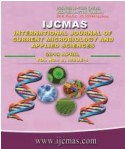


 National Academy of Agricultural Sciences (NAAS)
National Academy of Agricultural Sciences (NAAS)

|
PRINT ISSN : 2319-7692
Online ISSN : 2319-7706 Issues : 12 per year Publisher : Excellent Publishers Email : editorijcmas@gmail.com / submit@ijcmas.com Editor-in-chief: Dr.M.Prakash Index Copernicus ICV 2018: 95.39 NAAS RATING 2020: 5.38 |
A field experiments was conducted during winter seasons of 2014-15 and 2015-16 at the Agricultural Research Farm, Indian Agricultural Research Institute, New Delhi to study the effect of biofertlizer, herbicides, nitrogen management on crop growth and yield of wheat. The treatment consisted of two biofertilizer viz. No biofertilizer and Azotobacter, two levels of herbicides, viz. no herbicide, Clodinafop-propargyl application in main plot and three times of nitrogen application, viz. Chemical fertilizer (recommended dose of urea), Natural fertilizer + chemical fertilizer (50:50) and Natural fertilizer +chemical fertilizer (25:75) in sub plot treatment, respectively. Inoculation of Azotobacter resulted higher growth attributes, yield attributes, seed yield. Significantly higher value plant height was recorded under Azotobacter inoculated as compared to uninoculated. Dry matter accumulation was higher with Azotobacter inoculated than uninoculated plants. The highest value of these attributes was recorded with the application of Azotobacter which was significantly higher that the control (No biofertilizer) in present experimentation. Inoculation of Azotobacter resulted higher number of grains per spike (58.06 and 60.85) and grain weight (6.71 and 6.89 g) which was significantly more than uninoculated plants. The 1000 seed weight of wheat significantly increased with the application of Azotobacter. The highest seed yield (45.77 and 46.72 q/ha) was recorded with Azotobacter application which was significantly higher than uninoculated control (38.98 and 46.72 q/ha) during 2014-15 and 2015-16, respectively. Similarly straw, biological yield and harvest index of the crop was also improved significantly with Azotobacter application as compared to control. The growth attributes i.e. plant height and dry matter accumulation were found higher in Clodinafop – Propargyl 60 g ha-1 at 30 DAS while least growth attributes was recorded under untreated control during both the years. The treated plots exhibited significantly higher number of grains per spike (57.14 and 59.87), grain weight per spike (7.05 and 7.23 g) and 1000-grain weight than no weedicide control during respective years. The application of Clodinafop – Propargyl 60 g ha-1 at 30 produced significantly higher (45.15 and 46.62 q/ha) grain yield than untreated plots (36.59 and 40.57 q/ha). The nitrogen applied through urea or it was applied in combination with natural sources such as FYM had significant improvement on growth attributes and recorded higher plant height with 25% N applied through natural fertilizer + 75% nitrogen applied through urea recorded higher plant height than the other fertility treatments over the nitrogen applied through 50% natural + 50 % N applied through Urea. The combined application of 75% N by urea along with 25% natural fertilizer increased the number of effective tillers m-2, number of grains per spike, length of spike and the test weight. The combined application of 25% N applied by natural fertilizers + 75 N through urea + micronutrients registered highest (44.47 and 45.94 q/ha) grain yield of wheat during 2014-15 and 2015-16 of study which was significantly higher than the treatments where 50% N through natural + 50% through urea fertilizers were applied.
 |
 |
 |
 |
 |